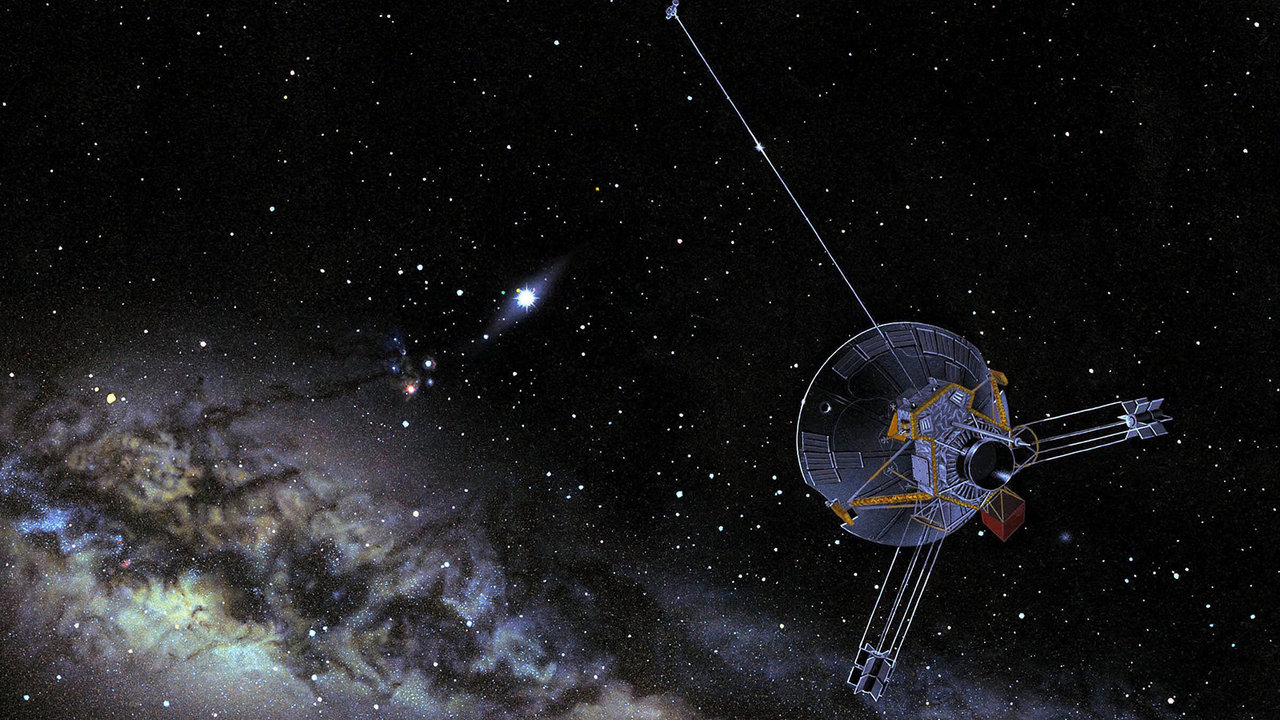News | September 29, 1995
Pioneer 11 to End Operations After Epic Career

Artist's concept of Pioneer spacecraft and the Milky Way Galaxy.
After nearly 22 years of exploration out to the farthest reaches of the Solar System, one of the most durable and productive space missions in history will come to a close.
Now beyond the orbit of Pluto and more than four billion miles from Earth, NASA's unmanned Pioneer 11 spacecraft is heading out into interstellar space. Because the spacecraft's power is too low to operate its instruments and transmit data, on September 30 NASA will cease daily communications with the spacecraft. At that distance, faint signals from Pioneer 11 traveling at the speed of light take over six hours to reach Earth.
The spacecraft will continue speeding out into interstellar space toward the center of the Milky Way, taking an engraved gold plaque bearing a message about Earth to other civilizations which it may encounter. Pioneer 11 will pass near the star Lambda Aquila in almost four million years.
"Americans should remember Pioneer 11 as a great achievement," said NASA Administrator Daniel Goldin. "This is the little spacecraft that could, a venerable explorer that has taught us a great deal about the Solar System and, in the end, about our own innate drive to learn. Pioneer 11 is what NASA is all about -- exploration beyond the frontier."
Some time in late 1996, its transmitter will fall silent altogether, and Pioneer 11 will travel as a ghost ship in our galaxy.
"Pioneer 11 has had a spectacular life," said project manager Fred Wirth of NASA's Ames Research Center, Mountain View, CA. "It was the second spacecraft to visit Jupiter, roaring through the heart of the planet's huge radiation belts at 107,373 mph, by far the fastest speed ever traveled by a human-made object."
Pioneer 10 and 11 were recommended by the Space Science Board of the National Academy of Sciences in 1968 as low-cost exploratory missions to the giant planets Jupiter and Saturn, approved by NASA in February 1969, and launched three and four years later, respectively.
Launched in April 1973, Pioneer 11 reached Jupiter in December 1974, following Pioneer 10, which flew by the planet a year earlier. It came in under the giant planet's south pole and skimmed within 26,600 miles of Jupiter's cloud tops. The fly-by was so close -- the closest passage ever made past Jupiter -- that the spacecraft received heavy bombardment from Jupiter's radiation belts, which are 40,000 times more intense than Earth's. Only Pioneer's extreme speed saved its electronics from severe damage.
Maps of Jupiter's severe radiation environment provided by Pioneer 10 and 11 permitted the later and much more sophisticated missions Voyager 1 and 2, and the ESA-NASA spacecraft Ulysses, to be designed to survive Jupiter's radiation. They also paved the way for Galileo's arrival at Jupiter in 1995, and the Cassini mission, launching to Saturn in 1997.
The gravity assist resulting from the close fly-by threw the craft 100 million miles above the plane of the planets and 1.5 billion miles completely across the inner solar system to Saturn. Pioneer flew high enough above the Sun's equatorial plane (17 degrees) to discover the true character of the Sun's magnetic field, until then a mystery to scientists.
In 1979, Pioneer 11 flew within 13,000 miles of Saturn, becoming the first spacecraft to visit that planet. Among its discoveries were two new moonlets and a new ring, and it charted the magnetosphere, magnetic field and the general structure of Saturn's interior. The spacecraft's instruments also measured the heat radiation from Saturn's interior, and found that its planet-sized moon, Titan, was too cold to support life.
In 1990 Pioneer 11 became the fourth spacecraft to journey beyond the Solar System, heading in the same direction that the Sun moves through interstellar space. Pioneer 10 is traveling in the opposite direction, and with the two Voyager spacecraft will continue to return information about the Sun's influence deep in space.
Although running out of power, most systems aboard the remarkably durable Pioneer 11 spacecraft are still healthy. For many years the spacecraft has been sending back limited data on the solar wind, magnetic field and cosmic rays, but it can no longer be maneuvered to point its antenna accurately at the Earth. Starting tomorrow, NASA controllers will use the Deep Space Network antennas to listen for the spacecraft's signal for about two hours every two to four weeks to gather whatever information they can, down from about eight to ten hours per day.
"Some time in late 1996, its transmitter will fall silent altogether, and Pioneer 11 will travel as a ghost ship in our galaxy," Wirth said. "We plan to listen to it once or twice a month to learn about the fade-down process. This will help us understand the future fate of its sister craft, Pioneer 10," he said.
Pioneer 10 continues to return scientific data and may have enough power to last until 1999. At almost six billion miles, Pioneer 10 is the most distant object built by humans. The Pioneer project is managed by NASA Ames Research Center, Mountain View, CA.
The Pioneers were built by TRW Systems, Redondo Beach, CA.


